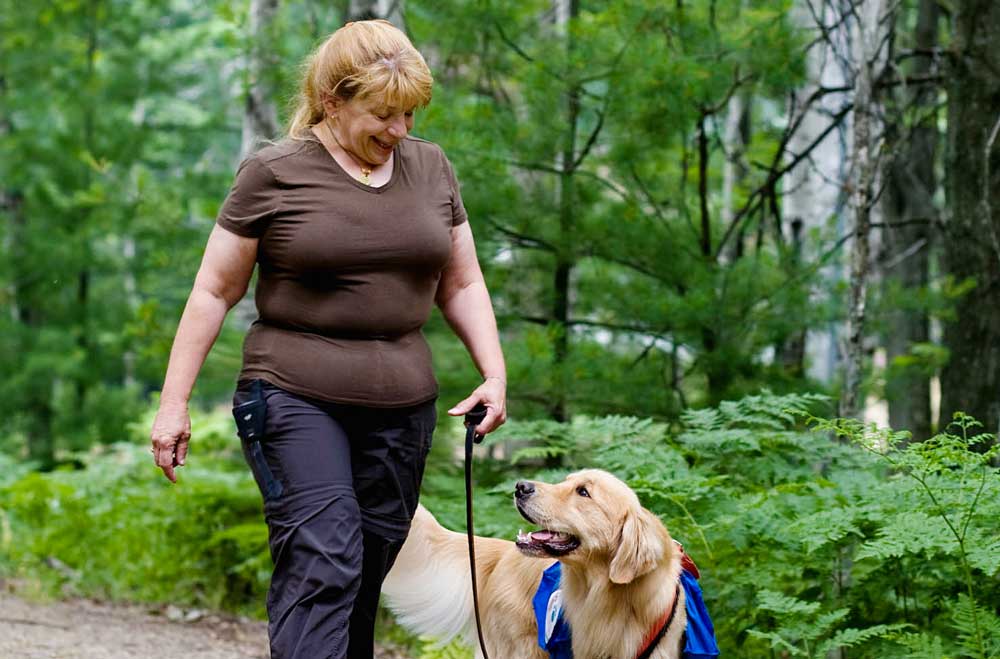SEIZURE RESPONSE DOGS
PAWS Seizure Response Dogs are custom-trained to assist people who have epilepsy with tasks such as activating a life-alert system, finding someone to help, retrieving a phone or stimulating a person during a seizure. As a person recovers from a seizure, a PAWS Dog can retrieve medications or food, act as a brace to help them up and provide comfort.
PAWS Seizure Response Dogs are NOT trained to protect or predict seizure activity. However, after several years with a client, some may develop the ability to alert their owner of an oncoming seizure. This behavior is not guaranteed to develop, nor to be consistent if it does develop.
In addition to performing tasks related to a seizure disorder, a PAWS Dog can also be trained to assist with tasks related to a physical disability or hearing loss.

QUALIFICATION
INFO
Determine if you qualify for a PAWS Seizure Response Dog
LEARN MORE
WHAT
TO EXPECT
Learn what to expect with a PAWS Seizure Response Dog
LEARN MORE
ASSISTANCE
DOG FAQ
Frequently asked questions about PAWS Seizure Response Dog
LEARN MORE
JOANNE AND
WILLIE’S STORY
Seizure Response Dog WILLIE saved Joanne from drowning
LEARN MORE
REQUEST APP
FOR PAWS DOG
Applications are open January 8th-March 29th, 2024.
REQUEST APP
DONATE
ONLINE
Give now to support an Assistance Dog Team
DONATE
JOANNE AND WILLIE’S STORY
“Before WILLIE, my life was extremely limited by seizures. With WILLIE, I was able to learn new things and go places. With each trip out, I gained confidence. I began traveling more. I found myself genuinely smiling.”
– Joanne, PAWS Seizure Response Dog Client

WILLIE and I met in November 1995, and we became a certified team in March 1996. He amazed me every day with his knowledge and abilities. Before WILLIE, my life was extremely limited by seizures. With WILLIE, I was able to learn new things and go places. With each trip out, I gained confidence. I began traveling more. I found myself genuinely smiling. WILLIE was the answer to many prayers because not only did he assist me physically, he was my true companion. He inspired me to travel, pick up my artist’s tools and camera.
With WILLIE by my side, dropped items got picked up, I took my medication on time and I got exercise and rest to reduce my seizures. When I did have a seizure, WILLIE provided life-saving responses. Eventually, after we worked together for many months, WILLIE learned and began alerting me to imminent seizures*. I remember one time I was taking pictures on a dock in the middle of a lake while WILLIE was on shore. He sensed a seizure coming and let someone know, which gave me time to get safely back to land before it hit. I had a grand mal seizure and could have fallen off the dock and drowned, but WILLIE saved my life.
After three years together, I was diagnosed with Myasthenia Gravis, a neuromuscular disease. WILLIE adapted once again by learning new tasks that helped me daily. I don’t know how PAWS did it, but they found the perfect Assistance Dog for me. Through our years, the most meaningful times were those spent living daily life together – WILLIE helping me and me helping WILLIE – both growing to our fullest potential.
A sincere thank you to all who prepared WILLIE for the invaluable assistance he gave me and thank you WILLIE for being you. Life will never be the same.
*PAWS Seizure Response Dogs are not trained to predict seizure activity. With time, some dogs may develop the ability to alert their client to an oncoming seizure. However, this behavior is not guaranteed to develop, nor to be consistent if it does develop.

QUALIFICATION INFORMATION
To be eligible for a PAWS Seizure Response Dog, an individual must:
- Be 14 years or older
-
An individual must have a minimum of one epileptic seizure a month. PAWS does not consider Absence Seizures (Petit-Mal) a qualifying seizure as typically there is no physical manifestation to trigger the dogs that they need to respond.
- If the dog is also trained for hearing tasks, an individual must have a minimum of moderate to severe bilateral hearing loss.
- Be physically and cognitively capable of participating in the training process, up to one hour a day
- Be able to independently command and handle their Assistance Dog
- Be able to meet the emotional, physical and financial needs of the Assistance Dog
- Be in a stable home environment
- Actively improve their quality of life and pursue independence with their Assistance Dog
- Have no other dog in the home (can have other animals)
- Live in an area serviced by a PAWS Field Rep (determined upon application)
If the applicant is younger than PAWS’ minimum age, visit www.assistancedogsinternational.org for a list of other ADI programs that may train for younger children.
While Paws With A Cause has established eligibility criterion for the types of Assistance Dogs we provide, we do not discriminate against any applicant based on race, color, creed, gender, religion, marital status, age, nationality, physical or mental disability, medical condition, sexual orientation, citizenship status, military service status or any other consideration as indicated by federal, state or local laws.

WHAT TO EXPECT
Paws With A Cause works hard to ensure each client is matched with an Assistance Dog that enhances their quality of life and independence. We know this is an ongoing process, which is why we strive to help each Assistance Dog Team prosper before, during and after certification.
CLIENT-DOG MATCHING
The search for a client’s dog match begins as soon as their Needs Assessment has been accepted. Our goal is to make the strongest possible match for each client in the “waiting pool.” Many factors are considered when evaluating a possible client-dog pairing. Depending on the individual client, and the particular qualities of each available PAWS Dog-in-Training, it may take up to two years to find the right match for their needs, temperament, and lifestyle.
CUSTOM-TRAINING
Once a client is matched, training begins. During these 3-6 months, trainers review a client’s needs assessment and video to custom-train the Assistance Dog for tasks to enhance a client’s independence and quality of life. PAWS’ training standards exceed the industry average. If a dog is unable to meet PAWS’ training standards, the client will be matched with another compatible PAWS Dog as soon as possible.
TEAM TRAINING
When training at PAWS Headquarters is complete, the Assistance Dog is placed with the client in their home and team training begins. Over the next 4-8 months, a PAWS Field Rep helps the client learn how to work with their Assistance Dog in the home, workplace, school, etc. When the client and PAWS Dog are working well together, the Field Rep videotapes them performing their tasks. This video is reviewed by PAWS Client Services and once approved, the Assistance Dog Team is certified and ownership of the PAWS Dog transfers to the client.
Assistance Dog Teams are tested and recertified every 24 months to ensure they continue to work well together. Follow up is conducted on alternate years or whenever a client needs additional assistance.
TEAM SUPPORT
After certification, PAWS remains available for support. Clients may contact PAWS Client Services at any time if extra training is needed, whether it’s a new task or retraining of an existing task. Assistance Dog Teams are also recertified every 24 months to ensure they are working at the required proficiency of PAWS and ADI.
When an Assistance Dog retires or passes away, PAWS clients are eligible to apply for a Successor Dog. If accepted, priority is given to successor clients for available Assistance Dogs.
Please note: A PAWS Assistance Dog will not be placed in a home with another dog unless it is a retired PAWS Dog or working Assistance Dog from an ADI or IGDF-accredited agency for someone else in the household. It has been our experience that other dogs in the home interfere with the bonding and training of the Assistance Dog Team.

Questions?
Please see our Assistance Dog FAQs here.

